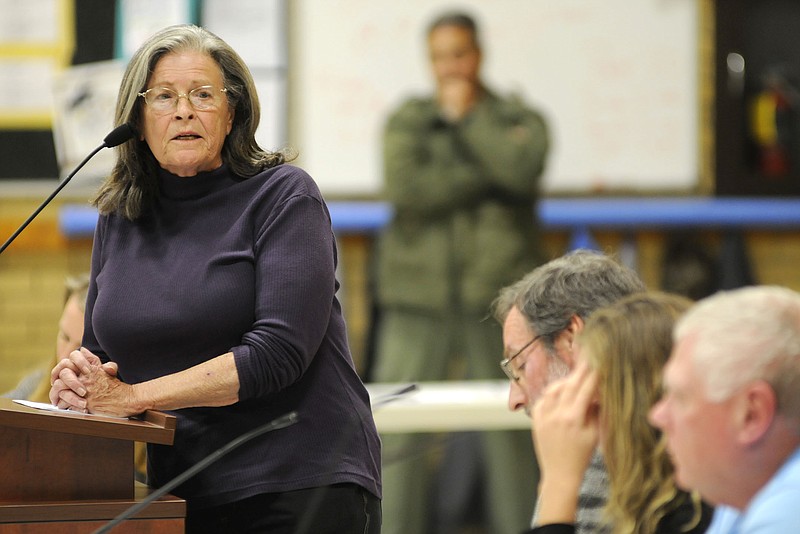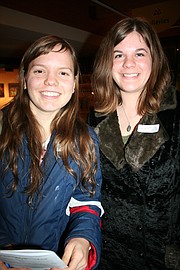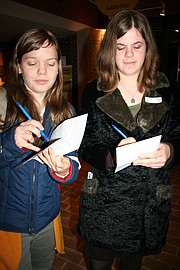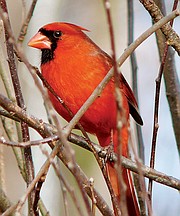Betty Jones was one of more than 15 people to speak in opposition to the proposed 10,000-hog confinement coming to Kingdom City Thursday night inside Hatton-McCredie Elementary School.
The Missouri Department of Natural Resources held the meeting after it received written letters of concern regarding the potential operation, which will be constructed on Horstmeier Farms where a smaller hog farm currently operates.
Jones said she didn't want to reiterate the comments made before her - expressing concern over how manure applied as fertilizer could affect waterways in Callaway County. Instead, she, a Sunday school teacher, told the Biblical story of David and Goliath to help prove her point and those before it.
In the tale, she said, David faces off against Goliath, a seemingly invincible warrior, with only a rock and slingshot in hand. He used the weapon to defeat the giant and save his people. She said the story would have gone differently if the stream from which David picked the rock was brown or black, referring to the color water changes to when effluent from confined animal feeding operations (CAFOs) spills into waterways.
"I don't know the future for our children and grandchildren, but I know without water there won't be a future and we need to keep that water clear," she said before taking her seat.
Although Jones used the water connection to further her point, another theme sounded throughout the meeting.
Opponents of the Kingdom City CAFO have been fighting their battle since May when they received a neighbor notification in the mail stating Eichelberger Farms Inc., an Iowa-based company, had intentions to establish a hog operation in the area. The concerned citizens organized into Friends of Responsible Agriculture, held a public meeting, wrote letters to the editor and hired an attorney to for legal guidance.
One by one they took to the podium seated in front of about 200 people and asked DNR representatives to deny application from Callaway Farrowing LLC (a spin-off company of Eichelberger).
While DNR representatives met with the public Thursday night supplying information, listening to worries and answering questions, state law dictates the agency's actions in accepting or denying the permit.
"If the facility meets all the design and operating permits that are established in the rules and regulations, then the department is required by law to issue the appropriate operating permit," Amanda Sappington, an environmental specialist with the DNR's Water Protection Program, said to the public.
Gena Terlizzi, spokeswoman for DNR, said the agency must make its decision to accept or deny the application by Nov. 21.
The Department of Natural Resources received Callaway Farrowing's application on July 31, at which time it was determined incomplete due to technicalities. According to an email from Greg Caldwell, DNR environmental specialist in the Water Protection Program, the initial application lacked a name, address and telephone number on the neighbor notification letter as well as the engineer's seal "stating that the project was designed in accordance with Missouri CAFO design regulations."
In addition to state law, Sappington said the DNR Water Protection Program abides by the rules and regulations in the federal Clean Water Act of 1972. She said the agency cannot address non-water quality health impacts, such as odor and air pollution outside of the buffer distance, quality of life, or community values, property values, treatment of animals, civil agreements, out-of-state or corporate ownership and location of the CAFO other than compliance with regulations.
The DNR also has no oversight over infrastructure problems - the legislature took away the department's ability to oversee CAFO construction through House Bill 28 in 2013. Sappington said the revision in law "exempted industries from construction permits unless they're building an urban basin or lagoon."
"So a facility like the one proposed is not required to obtain a construction permit from the department," she said. "It is still required to be designed by a professional engineer registered in Missouri ... The department still has the authority to follow up after construction to make sure everything is constructed according to regulation."
By that time, it's too late, said Kathy Martin, a professional engineer hired by FORAG to review Callaway Farrowing's application.
"Once any type of facility is built, you can't really fix it," Martin said. "It's like trying to build a home and then looking at the drawings afterward. Nobody in their right mind would do that, right?"
In terms of construction, Martin said Missouri is reliant on an engineer's signature for verification of a CAFO facility. Martin pointed out what she claims to be technical deficiencies in Callaway Farrowing's application.
According to materials Martin prepared, three ponds are located near the proposed hog site with the gilt isolation barn - which will house 1,920 females and 800 piglets - positioned over a pond. Each of the three barns on site will have deep pits to hold urine and feces. The hogs sit on slated floors, and as they walk, their feces falls through the cracks and into the pits.
John Everly, technical service provider with the Pinnacle Group - a firm hired by Eichelberger - Callaway Farrowing is in compliance with buffer zones from water sources, roads and residences.
"We have confirmed the distance from these manure storage structures, and all these structures will exceed the 100-foot minimum required by the Missouri DNR to the water sources," Everly said.
Martin also had a problem with the mortality disposal plan of the hogs and the composting design. Martin claimed the applicant's engineer used mortality estimates and disposal methods from Virgina Extension publications, not Missouri.
Callaway County is known for its clay-like soil. Because of the soil's compact nature, it's challenging for rain to seep into and often causes increased runoff.
But the application, Martin said, doesn't take soil into account either.
"I'm going to tell you as a professional engineer, it's critical to know the sub-surface material you are constructing any type of building on, especially one for storage of millions of gallons of untreated raw feces and urine," she said. "And, if that is not something that is being analyzed by the state, then you need to do something about it."
According to the application, the gestation facility will produce more than 2.5 million gallons of manure per year and the hogs in the farrowing building will produce more than 970, 000 gallons of manure per month. The gilt developer's pits will be 8 feet deep, holding an estimated 814,096 gallons per year. The pits will be pumped twice a year.
An Oct. 20 spill from Horstmeier Farms of 10,000 gallons of effluent increased community concerns.
Some of the manure will be used as fertilizer on land near the facility. It will be knifed into crop fields. DNR stated that the manure will be knifed during appropriate times when the land is neither saturated nor frozen and will not pose a threat to surrounding properties.
Shirley Kidwell, secretary of FORAG, lives about 3,500 feet away from the proposed site and still has concerns, which she expressed Thursday night.
"With every substantial rain, there's runoff through those ditches," Kidwell said. "That runoff goes into a three-acre pond next to my house that we built 35-40 years ago and our children learned to fish in it. Our grandchildren fished in it. My whole family has, and the neighborhood children have learned to fish and enjoy it from our pond."
She added that the pond overflow goes into Stinson Creek, which runs through Fulton.
FORAG spokesman Jeff Jones said the whole process works in favor of CAFOs as DNR provides the applicants with necessary improvements and then the applicant is allowed to make those changes.
"If they think it's worth it, they're going to keep going for it no matter how much we point out," Jones said.
If the DNR accepts Callaway Farrowing's application, Jones said FORAG will take the next step - appealing the decision.





